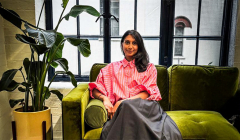
Why the creative industry needs to own its choices
When Hanisha Kotecha pushed for representation behind the lens she had a complaint filed against her, an experience she shares to spark change.

Paul Greenwood shares findings from We Are Social’s new report which examines trends in the creator landscape

A parent explaining the health benefits of ketamine. A Manhattanite it-girl, swapping ‘NYC’s best cocktail bars’ for Connecticut's best horse riding spots. A puppet show in which children’s dolls are sent to rehab for stealing a Marc Jacobs bag. These are just some of the examples of content from creators that feature in Next Gen Influence - We Are Social’s new report examining trends in the creator landscape.
We know that everything from tone to topics, to production norms have shifted in the decade since influence’s infancy. Creators and brands are having to keep pace with an increasingly professionalised landscape. But it’s also changed audiences, with the demand for original and authentic content escalating, even as understandings of ‘originality’ and ‘authenticity’ grow murkier.
For today’s brands and creators, it’s essential to peek around the corner and prepare for the shifts that are coming, and which brands and creators are driving them. These are the five areas we see having the greatest impact on the influencer ecosystem in the near future:
Social loves a ‘journey’, but in today’s creator economy, this focus on the journey has complicated our idea of authenticity. Authenticity used to require consistency, but today – with child influencers growing up, and mainstays ageing out – audiences are used to watching people change. In this context, creators are planning their evolutions to draw in new viewers.
Julie Vu, the first transgender houseguest on Big Brother Canada, is masterful for her glamour and her humour. But she’s really won the love of audiences for making content that narrativises and visualises ‘the journey’ of her trans evolution, as much as the destination.
Aspirational content is the bread and butter of influence. But today – with most people striving for stability, not luxury – aspiration is having to change shape to stay realistic. Now, creators peddling ‘the good life’ are having to reappraise what that life looks like to make it feel relevant for real people. This means lifestyle content that’s less about glamour and luxury, and more about calm and stability.
@hart_of_shetland – a former city-dweller now making ethical crafts on the Shetland Islands – shows off her enviable vistas and close-knit neighbourhood. But lifestyle content feels real and achievable to non-capital city audiences, offering alternative perspectives to urban-dominated social.
In recent years we’ve seen creators engage in acts of altruism to demonstrate their ethical credentials – a trend embodied by Mr. Beast's loud charitable endeavours. But in this context, there’s increasing concern that philanthropy is being used for the purpose of online clout. As audiences become sceptical of moral posturing, creators are swapping work that claims values for work that actively disrupts or challenges the status quo.
Kahlil Greene, a Gen Z historian on TikTok, uses his platform to resurface and challenge obscure or forgotten historical truths – whether that’s Mexico’s having its first Black president 200 years before the US had Obama, or the Black history of cowboys. He encourages viewers to wield this knowledge to spur real change, like showing the precedent for reparations.
On today’s social channels, a new wave of culturally impactful creativity is at play, driven forward by creators who’ve mastered ‘very online’ modes of communicating. These approaches – from making work inspired by fanfic to repackaging vulnerability as entertainment – are pushing the creative bar higher for everyone, but especially for brands, who have to be as entertaining as their human counterparts, but without the human charm or licence for imperfection offered to real people.
Subversive undertones are everywhere on social. While brands themselves might get side-eye for poking fun at topics like addiction, partnerships with playfully risqué creators – like Marc Jacobs’ work with @sylvaniandrama – gives brands more licence to participate in irreverent, ‘very online’ humour.
The ‘dead internet theory’ is one of many laments of how bots, trend cycles, and garbage content have thrust online creativity into crisis. For today’s creators – who find themselves wading through a sea of content that’s loud and fast-moving, but often lacking in creative merit – it’s difficult to stand out. As the next generation of creators navigate this space, they’re leaning into the unusual and extreme, trying to break the internet's unspoken rules to make an impact.
To combat this sea of sameness, creators like Max Webb are pushing the broad space of sports content to its furthest extreme, with lo-fi, high-octane adventure content showcasing elaborate feats of human achievement.
Find out more in the full Next Gen Influence report.
Paul leads as the global head of research & insight at We Are Social, spearheading the Insights and Effectiveness teams. He plays a pivotal role in driving the agency's cultural insights offering, empowering brands to cultivate a nuanced understanding of digital (sub-)cultures, and actively contributes to the agency's global thought leadership initiatives, positioning We Are Social as a trusted authority in the industry. He’s also responsible for the development of robust measurement standards, proving the value of social content and campaigns for clients. With a keen focus on fostering consistency in reporting and insight generation across diverse markets, Paul oversees the agency's global measurement frameworks, effectively disseminating knowledge, sharing best practices, and tracking the performance of social strategies against pre-established benchmarks.
Looks like you need to create a Creativebrief account to perform this action.
Create account Sign inLooks like you need to create a Creativebrief account to perform this action.
Create account Sign in